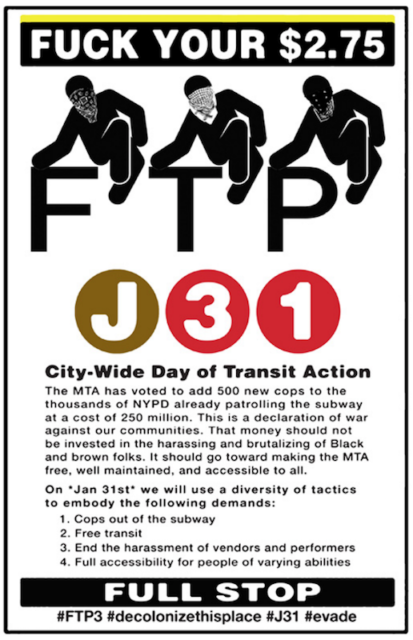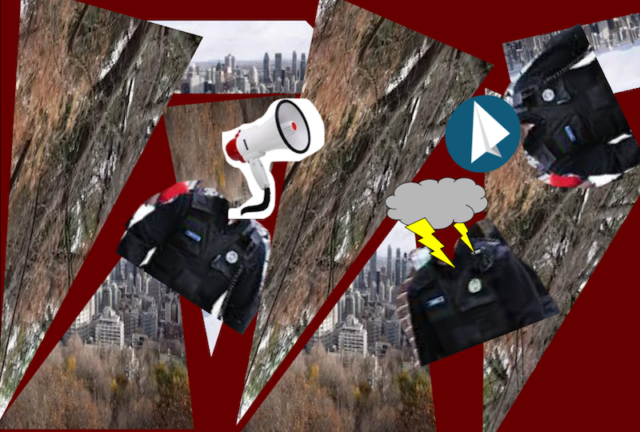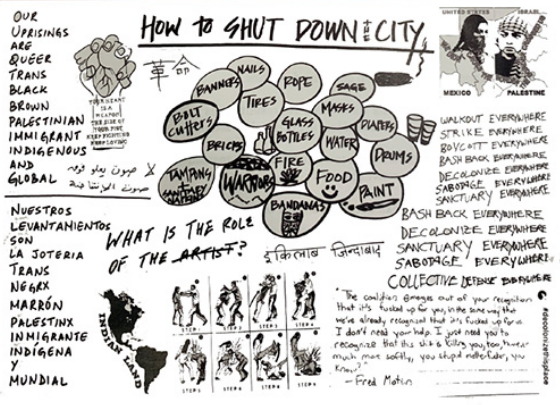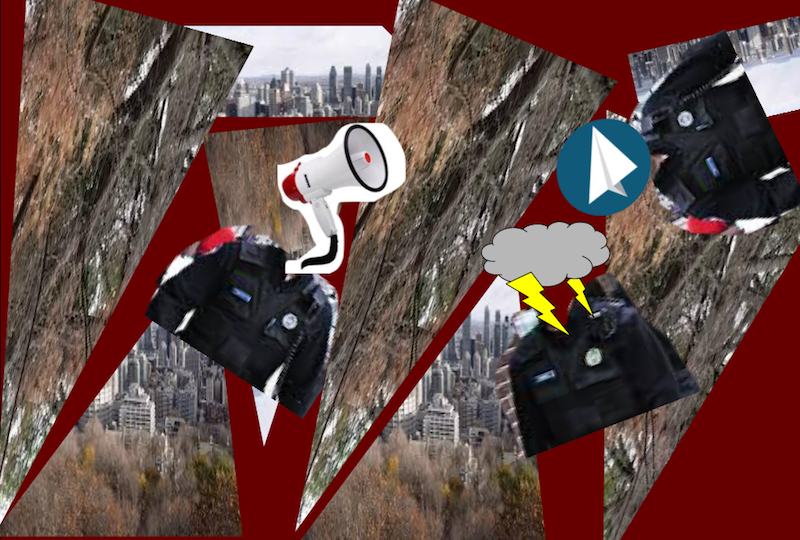On Friday, January 31, people turned out en masse to protest against police presence in the New York City transit system, the Metropolitan Transportation Authority (MTA). The protests included mass turnstile hops across the city, campus walkouts and park assemblies, and speak-outs in stations and on campuses against police presence in schools and subways, and originally, a final mass turnstile hop at Grand Central Station at 5:00 p.m. This final act of protest did not take place due to heavy police presence. Arno Pedram, a reporter on the event said “packs of police officers [were] waiting at locations, about 50 at the Grand Central turnstiles, another 50 in the main concourse, and even more in Times Square.” Close to 500 protesters continued to relocate, ending up in Bed-Stuy. A representative from Decolonize This Place noted that folks were able to take part in mass turnstile hops at multiple stations elsewhere, since the protests were decentralized, prior to some stations being shut down. In addition to protest signs and widespread graffiti, demonstrators posted examples on social media of methods to keep the turnstile system inactive, such as propping exit doors open and filling swipe machines with Super Glue. Dubbed #J31 / FTPIII, this was the third in a series of “fuck the police” (FTP) protests. The city-wide day of transit action was carried out to embody the following demands: 1. Cops out of the subway. 2. Free Transit. 3. End the harassment of vendors and performers. 4. Full accessibility for people of varying abilities.
1. Cops out of the subway. 2. Free Transit. 3. End the harassment of vendors and performers. 4. Full accessibility for people of varying abilities.
These protests have been facilitated by Decolonize This Place, an action-oriented decolonial movement in New York City. The organization “brings together many strands of analysis and traditions of resistance: Indigenous insurgence, black liberation, free Palestine, free Puerto Rico, the struggles of workers and debtors, de-gentrification, migrant justice, dismantling patriarchy, and more.” Ahead of #J31, the collective provided public information surrounding the MTA, the NYPD, and ways to organize autonomously and safely via social media and in a series of communiques.
The first series of FTP protests took place on November 1, 2019, as an emergency action organized in response to circulating videos of police brutality in the MTA against Black and Brown youth. On November 22, 2019, a second action was carried out in even larger numbers, met with a more extreme militarized response and ultimately resulted in 58 arrests. In December 2019, the MTA board affirmed Governor Cuomo’s call for increased crackdowns on fare evasion and attacks on transit workers through the addition of 500 cops into the MTA system. Fare evasion is cited as a major cause of revenue loss – $240M USD from March 2018-2019 – for the MTA, which remains heavily in debt. Proposed installation of surveillance cameras to cover turnstiles at all subway stations is earmarked at approximately $250M, and the cost of additional officers pushes the MTA deficit to $1B. Amidst this, multiple officers have confirmed being explicitly told to target Black and Hispanic people to fulfill arrest quotas. Though predicated on financial rhetoric, the crackdown on fare evasion indexes a focus on security through the criminalization of racialized people and those living in poverty. Representative Alexandria Ocasio-Cortez has spoken out against Cuomo’s transit plans, demanding an improvement in transit services in lieu of policy which targets racialized individuals, and criminalizes poverty by burdening those who can’t afford a $2.75 fare.
In an interview with the Daily, Decolonize this Place said that the response to the November 1 action was much greater than anticipated, which speaks to the fact that the issue of over-policing in subways resonates across the city. They shared that the formation of FTP action to date has been in line with their principles of unity, enabling individuals to take action in methods that work best for them.
“The vision on the horizon is for diversity of liberation, which requires diversity of tactics. Organize with the crew you trust, your friends, and organize actions that are appropriate. This builds horizontal power. We are all pushing where we are, in the positions we are in, with the capacity that we have, with the skills that we hold. By pushing at every front, this allows people to participate at the levels that they are at, which does help a large number of people to participate.”
Social media has been a central part of this strategy, acting as a “feedback loop” for both information sharing and organization. “Social media is a way to put out our own narrative – it needs to feed back into organizing and what is happening on the ground, in terms of actions, and then in turn to let people know about the action.” Because the accounts have been frequently blocked and shadowbanned, the organizers have several backup accounts to continue circulating information.
In addition to this online resource presence, the week ahead of #J31 was a week for organizing and trainings. “These have been a place to plug in [to what’s going on], workshop ideas for action, and have training around knowing your rights, and in medical responses in case something happens.”

NBC reported early Friday that command staff within the NYPD had been told that, “while we will always protect people’s right to protest, illegal conduct that puts law-abiding community [sic] and cops in danger will not be tolerated in New York City.” With respect to the mass arrests made during FTPII, Decolonize this Place highlights that a large part of the action has been jail support for those arrested. “Action isn’t over until everyone is out. We are tracing these people so we know where they are in the system.” Following the Grand Central assembly at 5:00 p.m., protesters moved towards Brooklyn. As of 7:00 p.m. on Friday, January 31, social media reports indicated heavy police presence and arrests being made at Grand Central Station, with police barricading Bryant Park station, where a mass fare evasion took place. Photos and video footage shows police using excessive force against protestors.
“Organize with the crew you trust […] and organize actions that are appropriate […] We are all pushing where we are, in the positions we are in, with the capacity that we have, with the skills that we hold.” – Decolonize This Place
Though Canada often positions itself as more progressive than its southern counterpart, the increased policing of racialized bodies in transit systems is blatantly apparent in Montreal. In April of last year, the Board of Directors of the Montreal Transit Authority (STM) proposed a plan to grant police-like powers to STM transit inspectors. Racial profiling by the Service de Police de la Ville de Montréal (SPVM) and the brutalization of fare evaders by STM inspectors has been widely documented in qualitative research and on social media. While Quebec does have a police watchdog, The Bureau des enquêtes indépendantes (BEI), it has been questioned on its efficacy relative to other police watchdogs nationally and on whether it is effectively serving its function. Simultaneously, city officials have taken steps to acknowledge that discrimination is taking place. In summer 2019, a Supreme Court Judge authorized a racial profiling class-action lawsuit launched by the Black Coalition of Quebec against the City of Montreal, acknowledging that racial profiling within the SPVM is a problem. Shortly thereafter, results of a report studying police interceptions in Montreal over the period of 2014 and 2017 were publicly released.
The report found that Black and Indigenous peoples were four times more likely to be subject to street checks than white people, while Arab people were were two times more likely. Montreal police chief Sylvain Caron acknowledged the report’s findings, but attributed them to individual implicit biases on the level of police officers, rather than institutionalized racism. “We don’t have racist police officers, we have police officers who are citizens, and who, inevitably, have biases like all citizens have.”

Taken in contrast with the explicit targeting of Black and Brown bodies by the NYPD, the narrative attributing increased checks on racialized bodies to implicit bias tries to negate the possibility of systemic racism. Balarama Holness, an educator, law student, and activist with Montreal en action, spoke with the Daily about the status of racial profiling in Montreal. He commented that the claim that the numbers outlined in the report are attributable to implicit bias alone is false. He explains that where those in positions of power are given authority to systematically act (and enforce) their own implicit biases, it becomes an explicit bias. “The action taken by police in New York has been overt, but in Montreal it is the same thing. There is a set of normative legal rules within the system that permits that – it is a vicious cycle, and a self-fulfilling prophecy.”
This self-fulfilling prophecy is also reflected in the report to the SPVM. Between the period of 2014 to 2017, targeting also increased – according to the report’s analysis, an Indigenous woman was three times more likely to be stopped in 2017 than in 2014. Overall, street checks increased during the four year period, from 19,000 per year to more than 45,000 per year. The heavier policing of areas deemed “high risk” leads to more arrests, causing the overrepresentation of people from those areas in the system. Holness adds that the structural nature of systemic racism and cycles of economic inequality mean that proposed increased transit policing is especially confusing for many people. “Many young people [from all over the city] take the Metro and appear to be ‘loitering,’ and by [VP Craig Sauve of the STM] pushing for more police-like powers, the state and the STM and the SPVM are taking more from a community that needs space to breathe.”
The Daily asked Holness about potential tension in public perceptions of the police. “The state is the creator of culture, and they create the culture of how we see them. They are often wearing army uniforms, which sends a specific message. It is confusing to be called ‘agents of peace,’ and to be wearing military uniforms. This to me speaks volumes, because it tells us what you think about yourself in that position. Civil disobedience can take many forms, but ultimately the form of protest is the message.”

In Montreal, anti-racism and antidiscrimination activists have pushed hard for system-wide change, leading to a public consultation on systemic racism and discrimination led by the Office de la consultation publique (OCPM). Montreal en action, led by Holness, began collecting signatures in 2017, ultimately collecting 22,000 signatures to mandate the consultation process. The consultation has offered a forum to citizens to challenge the city on its approach to accessibility, diversity and inclusion, and the systemic barriers racialized citizens face. The OCPM’s final recommendations to the city will be released in March, 90 days after the final consultations were held. Holness is hopeful that the recommendations will be impactful. “They should have enough teeth to move the city forward, and will have an effective language. As they are built around municipal jurisdiction, [the recommendations] will be specific enough to implement and measure success throughout the years.” Ahead of the recommendations, the Quebec Human Rights Commission urged Montreal to set a precedent for the rest of Quebec by taking concrete action to address systemic discrimination. They recommended the City of Montreal, SPVM, and STM “take steps to serve the ethnocultural and diverse population they serve,” through removing employment barriers and discriminatory policies, and increasing access to housing.
Where those in positions of power are given authority to systematically act (and enforce) their own implicit biases, it becomes an explicit bias.
While the specific demands and approaches taken by activists in Montreal and New York are divergent, the parallels between them highlight a global and urgent movement towards decolonization of our shared spaces. Through different instruments, the impacts of these acts of civic action and engagement speak to the power citizens hold to enforce accountability. “People are becoming more and more aware that participatory democracy is a continued daily activity,” says Holness. “People in political positions of power don’t have issues in their core interests unless it is something that will get them elected. Civil society is going to decide which and whether or not issues get taken up.”
A previous version of this article incorrectly stated that the mass turnstile hop at Grand Central station at 5:00 p.m. took place. However, due to heavy police presence, Decolonize This Place protestors were unable to carry out this action.
